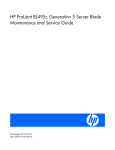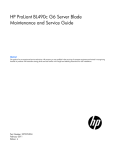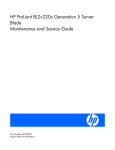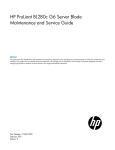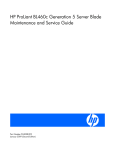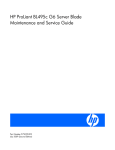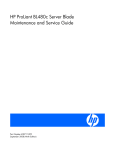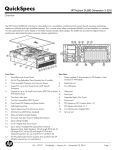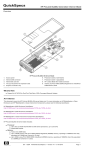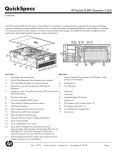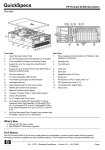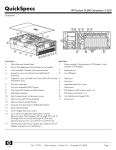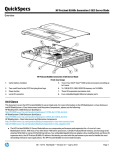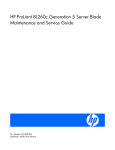Download HP BL680c G5 Specifications
Transcript
HP ProLiant BL680c Generation 5 Server Blade
Maintenance and Service Guide
Part Number 452659-004
December 2010 (Fourth Edition)
© Copyright 2007, 2010 Hewlett-Packard Development Company, L.P.
The information contained herein is subject to change without notice. The only warranties for HP products and services are set forth in the express
warranty statements accompanying such products and services. Nothing herein should be construed as constituting an additional warranty. HP
shall not be liable for technical or editorial errors or omissions contained herein.
Microsoft and Windows are U.S. registered trademarks of Microsoft Corporation.
Intel and Xeon are trademarks or registered trademarks of Intel Corporation or its subsidiaries in the United States and other countries.
Intended audience
This guide is for an experienced service technician. HP assumes you are qualified in the servicing of
computer equipment and trained in recognizing hazards in products with hazardous energy levels and
are familiar with weight and stability precautions for rack installations.
Contents
Customer self repair ...................................................................................................................... 5
Parts only warranty service ......................................................................................................................... 5
Illustrated parts catalog ............................................................................................................... 16
Server blade components ......................................................................................................................... 16
Removal and replacement procedures ........................................................................................... 22
Required tools ......................................................................................................................................... 22
Safety considerations ............................................................................................................................... 22
Preventing electrostatic discharge .................................................................................................... 22
Server blade warnings and cautions ................................................................................................ 22
Symbols on equipment ................................................................................................................... 23
Server blade preparation ......................................................................................................................... 23
Power down the server blade .......................................................................................................... 23
Remove the server blade ................................................................................................................ 24
Access panel .......................................................................................................................................... 25
FBDIMM baffles ...................................................................................................................................... 26
Hard drive blank ..................................................................................................................................... 27
Hard drive.............................................................................................................................................. 27
FBDIMM ................................................................................................................................................ 28
Mezzanine card...................................................................................................................................... 28
HP Smart Array P400i Controller battery pack ............................................................................................ 29
HP Smart Array P400i Controller cache module .......................................................................................... 30
Hard drive backplane .............................................................................................................................. 30
Front panel/hard drive cage assembly ....................................................................................................... 31
Server blade handle ................................................................................................................................ 32
Release button ........................................................................................................................................ 32
Heatsink ................................................................................................................................................. 33
Processor ............................................................................................................................................... 34
System battery ........................................................................................................................................ 37
System board ......................................................................................................................................... 38
Diagnostic tools .......................................................................................................................... 44
HP Insight Diagnostics .............................................................................................................................. 44
HP Insight Diagnostics survey functionality .................................................................................................. 44
Integrated Management Log ..................................................................................................................... 44
Array Diagnostic Utility ............................................................................................................................ 45
Redundant ROM support .......................................................................................................................... 45
Server component identification .................................................................................................... 46
Front panel components ........................................................................................................................... 46
Front panel LEDs ..................................................................................................................................... 47
SAS and SATA hard drive LEDs................................................................................................................. 48
SAS and SATA hard drive LED combinations .............................................................................................. 48
System board components ........................................................................................................................ 49
Mezzanine connector definitions ..................................................................................................... 50
FBDIMM slots ................................................................................................................................ 50
System maintenance switch ............................................................................................................. 50
Contents
3
System maintenance switch procedures ............................................................................................ 51
HP c-Class Blade SUV Cable..................................................................................................................... 52
Specifications ............................................................................................................................. 53
Environmental specifications ..................................................................................................................... 53
Server blade specifications ....................................................................................................................... 53
Acronyms and abbreviations ........................................................................................................ 54
Index ......................................................................................................................................... 58
Contents
4
Customer self repair
HP products are designed with many Customer Self Repair (CSR) parts to minimize repair time and allow
for greater flexibility in performing defective parts replacement. If during the diagnosis period HP (or HP
service providers or service partners) identifies that the repair can be accomplished by the use of a CSR
part, HP will ship that part directly to you for replacement. There are two categories of CSR parts:
•
Mandatory—Parts for which customer self repair is mandatory. If you request HP to replace these
parts, you will be charged for the travel and labor costs of this service.
•
Optional—Parts for which customer self repair is optional. These parts are also designed for
customer self repair. If, however, you require that HP replace them for you, there may or may not be
additional charges, depending on the type of warranty service designated for your product.
NOTE: Some HP parts are not designed for customer self repair. In order to satisfy the customer warranty,
HP requires that an authorized service provider replace the part. These parts are identified as "No" in the
Illustrated Parts Catalog.
Based on availability and where geography permits, CSR parts will be shipped for next business day
delivery. Same day or four-hour delivery may be offered at an additional charge where geography
permits. If assistance is required, you can call the HP Technical Support Center and a technician will help
you over the telephone. HP specifies in the materials shipped with a replacement CSR part whether a
defective part must be returned to HP. In cases where it is required to return the defective part to HP, you
must ship the defective part back to HP within a defined period of time, normally five (5) business days.
The defective part must be returned with the associated documentation in the provided shipping material.
Failure to return the defective part may result in HP billing you for the replacement. With a customer self
repair, HP will pay all shipping and part return costs and determine the courier/carrier to be used.
For more information about HP's Customer Self Repair program, contact your local service provider. For
the North American program, refer to the HP website (http://www.hp.com/go/selfrepair).
Parts only warranty service
Your HP Limited Warranty may include a parts only warranty service. Under the terms of parts only
warranty service, HP will provide replacement parts free of charge.
For parts only warranty service, CSR part replacement is mandatory. If you request HP to replace these
parts, you will be charged for the travel and labor costs of this service.
Réparation par le client (CSR)
Les produits HP comportent de nombreuses pièces CSR (Customer Self Repair = réparation par le client)
afin de minimiser les délais de réparation et faciliter le remplacement des pièces défectueuses. Si pendant
la période de diagnostic, HP (ou ses partenaires ou mainteneurs agréés) détermine que la réparation peut
être effectuée à l'aide d'une pièce CSR, HP vous l'envoie directement. Il existe deux catégories de pièces
CSR:
Customer self repair 5
Obligatoire - Pièces pour lesquelles la réparation par le client est obligatoire. Si vous demandez à HP de
remplacer ces pièces, les coûts de déplacement et main d'œuvre du service vous seront facturés.
Facultatif - Pièces pour lesquelles la réparation par le client est facultative. Ces pièces sont également
conçues pour permettre au client d'effectuer lui-même la réparation. Toutefois, si vous demandez à HP de
remplacer ces pièces, l'intervention peut ou non vous être facturée, selon le type de garantie applicable à
votre produit.
REMARQUE: Certaines pièces HP ne sont pas conçues pour permettre au client d'effectuer lui-même la
réparation. Pour que la garantie puisse s'appliquer, HP exige que le remplacement de la pièce soit
effectué par un Mainteneur Agréé. Ces pièces sont identifiées par la mention "Non" dans le Catalogue
illustré.
Les pièces CSR sont livrées le jour ouvré suivant, dans la limite des stocks disponibles et selon votre
situation géographique. Si votre situation géographique le permet et que vous demandez une livraison le
jour même ou dans les 4 heures, celle-ci vous sera facturée. Pour bénéficier d'une assistance
téléphonique, appelez le Centre d'assistance technique HP. Dans les documents envoyés avec la pièce de
rechange CSR, HP précise s'il est nécessaire de lui retourner la pièce défectueuse. Si c'est le cas, vous
devez le faire dans le délai indiqué, généralement cinq (5) jours ouvrés. La pièce et sa documentation
doivent être retournées dans l'emballage fourni. Si vous ne retournez pas la pièce défectueuse, HP se
réserve le droit de vous facturer les coûts de remplacement. Dans le cas d'une pièce CSR, HP supporte
l'ensemble des frais d'expédition et de retour, et détermine la société de courses ou le transporteur à
utiliser.
Pour plus d'informations sur le programme CSR de HP, contactez votre Mainteneur Agrée local. Pour plus
d'informations sur ce programme en Amérique du Nord, consultez le site Web HP
(http://www.hp.com/go/selfrepair).
Service de garantie "pièces seules"
Votre garantie limitée HP peut inclure un service de garantie "pièces seules". Dans ce cas, les pièces de
rechange fournies par HP ne sont pas facturées.
Dans le cadre de ce service, la réparation des pièces CSR par le client est obligatoire. Si vous demandez
à HP de remplacer ces pièces, les coûts de déplacement et main d'œuvre du service vous seront facturés.
Riparazione da parte del cliente
Per abbreviare i tempi di riparazione e garantire una maggiore flessibilità nella sostituzione di parti
difettose, i prodotti HP sono realizzati con numerosi componenti che possono essere riparati direttamente
dal cliente (CSR, Customer Self Repair). Se in fase di diagnostica HP (o un centro di servizi o di
assistenza HP) identifica il guasto come riparabile mediante un ricambio CSR, HP lo spedirà direttamente
al cliente per la sostituzione. Vi sono due categorie di parti CSR:
Obbligatorie – Parti che devono essere necessariamente riparate dal cliente. Se il cliente ne affida la
riparazione ad HP, deve sostenere le spese di spedizione e di manodopera per il servizio.
Opzionali – Parti la cui riparazione da parte del cliente è facoltativa. Si tratta comunque di componenti
progettati per questo scopo. Se tuttavia il cliente ne richiede la sostituzione ad HP, potrebbe dover
sostenere spese addizionali a seconda del tipo di garanzia previsto per il prodotto.
Customer self repair 6
NOTA: alcuni componenti HP non sono progettati per la riparazione da parte del cliente. Per rispettare
la garanzia, HP richiede che queste parti siano sostituite da un centro di assistenza autorizzato. Tali parti
sono identificate da un "No" nel Catalogo illustrato dei componenti.
In base alla disponibilità e alla località geografica, le parti CSR vengono spedite con consegna entro il
giorno lavorativo seguente. La consegna nel giorno stesso o entro quattro ore è offerta con un
supplemento di costo solo in alcune zone. In caso di necessità si può richiedere l'assistenza telefonica di
un addetto del centro di supporto tecnico HP. Nel materiale fornito con una parte di ricambio CSR, HP
specifica se il cliente deve restituire dei componenti. Qualora sia richiesta la resa ad HP del componente
difettoso, lo si deve spedire ad HP entro un determinato periodo di tempo, generalmente cinque (5) giorni
lavorativi. Il componente difettoso deve essere restituito con la documentazione associata nell'imballo di
spedizione fornito. La mancata restituzione del componente può comportare la fatturazione del ricambio
da parte di HP. Nel caso di riparazione da parte del cliente, HP sostiene tutte le spese di spedizione e
resa e sceglie il corriere/vettore da utilizzare.
Per ulteriori informazioni sul programma CSR di HP contattare il centro di assistenza di zona. Per il
programma in Nord America fare riferimento al sito Web HP (http://www.hp.com/go/selfrepair).
Servizio di garanzia per i soli componenti
La garanzia limitata HP può includere un servizio di garanzia per i soli componenti. Nei termini di
garanzia del servizio per i soli componenti, HP fornirà gratuitamente le parti di ricambio.
Per il servizio di garanzia per i soli componenti è obbligatoria la formula CSR che prevede la riparazione
da parte del cliente. Se il cliente invece richiede la sostituzione ad HP, dovrà sostenere le spese di
spedizione e di manodopera per il servizio.
Customer Self Repair
HP Produkte enthalten viele CSR-Teile (Customer Self Repair), um Reparaturzeiten zu minimieren und
höhere Flexibilität beim Austausch defekter Bauteile zu ermöglichen. Wenn HP (oder ein HP
Servicepartner) bei der Diagnose feststellt, dass das Produkt mithilfe eines CSR-Teils repariert werden
kann, sendet Ihnen HP dieses Bauteil zum Austausch direkt zu. CSR-Teile werden in zwei Kategorien
unterteilt:
Zwingend – Teile, für die das Customer Self Repair-Verfahren zwingend vorgegeben ist. Wenn Sie den
Austausch dieser Teile von HP vornehmen lassen, werden Ihnen die Anfahrt- und Arbeitskosten für diesen
Service berechnet.
Optional – Teile, für die das Customer Self Repair-Verfahren optional ist. Diese Teile sind auch für
Customer Self Repair ausgelegt. Wenn Sie jedoch den Austausch dieser Teile von HP vornehmen lassen
möchten, können bei diesem Service je nach den für Ihr Produkt vorgesehenen Garantiebedingungen
zusätzliche Kosten anfallen.
HINWEIS: Einige Teile sind nicht für Customer Self Repair ausgelegt. Um den Garantieanspruch des
Kunden zu erfüllen, muss das Teil von einem HP Servicepartner ersetzt werden. Im illustrierten Teilekatalog
sind diese Teile mit „No“ bzw. „Nein“ gekennzeichnet.
CSR-Teile werden abhängig von der Verfügbarkeit und vom Lieferziel am folgenden Geschäftstag
geliefert. Für bestimmte Standorte ist eine Lieferung am selben Tag oder innerhalb von vier Stunden gegen
einen Aufpreis verfügbar. Wenn Sie Hilfe benötigen, können Sie das HP technische Support Center
Customer self repair 7
anrufen und sich von einem Mitarbeiter per Telefon helfen lassen. Den Materialien, die mit einem CSRErsatzteil geliefert werden, können Sie entnehmen, ob das defekte Teil an HP zurückgeschickt werden
muss. Wenn es erforderlich ist, das defekte Teil an HP zurückzuschicken, müssen Sie dies innerhalb eines
vorgegebenen Zeitraums tun, in der Regel innerhalb von fünf (5) Geschäftstagen. Das defekte Teil muss
mit der zugehörigen Dokumentation in der Verpackung zurückgeschickt werden, die im Lieferumfang
enthalten ist. Wenn Sie das defekte Teil nicht zurückschicken, kann HP Ihnen das Ersatzteil in Rechnung
stellen. Im Falle von Customer Self Repair kommt HP für alle Kosten für die Lieferung und Rücksendung auf
und bestimmt den Kurier-/Frachtdienst.
Weitere Informationen über das HP Customer Self Repair Programm erhalten Sie von Ihrem Servicepartner
vor Ort. Informationen über das CSR-Programm in Nordamerika finden Sie auf der HP Website unter
(http://www.hp.com/go/selfrepair).
Parts-only Warranty Service (Garantieservice
ausschließlich für Teile)
Ihre HP Garantie umfasst möglicherweise einen Parts-only Warranty Service (Garantieservice
ausschließlich für Teile). Gemäß den Bestimmungen des Parts-only Warranty Service stellt HP Ersatzteile
kostenlos zur Verfügung.
Für den Parts-only Warranty Service ist das CSR-Verfahren zwingend vorgegeben. Wenn Sie den
Austausch dieser Teile von HP vornehmen lassen, werden Ihnen die Anfahrt- und Arbeitskosten für diesen
Service berechnet.
Reparaciones del propio cliente
Los productos de HP incluyen muchos componentes que el propio usuario puede reemplazar (Customer
Self Repair, CSR) para minimizar el tiempo de reparación y ofrecer una mayor flexibilidad a la hora de
realizar sustituciones de componentes defectuosos. Si, durante la fase de diagnóstico, HP (o los
proveedores o socios de servicio de HP) identifica que una reparación puede llevarse a cabo mediante el
uso de un componente CSR, HP le enviará dicho componente directamente para que realice su
sustitución. Los componentes CSR se clasifican en dos categorías:
•
Obligatorio: componentes para los que la reparación por parte del usuario es obligatoria. Si solicita
a HP que realice la sustitución de estos componentes, tendrá que hacerse cargo de los gastos de
desplazamiento y de mano de obra de dicho servicio.
•
Opcional: componentes para los que la reparación por parte del usuario es opcional. Estos
componentes también están diseñados para que puedan ser reparados por el usuario. Sin embargo,
si precisa que HP realice su sustitución, puede o no conllevar costes adicionales, dependiendo del
tipo de servicio de garantía correspondiente al producto.
NOTA: Algunos componentes no están diseñados para que puedan ser reparados por el usuario. Para
que el usuario haga valer su garantía, HP pone como condición que un proveedor de servicios
autorizado realice la sustitución de estos componentes. Dichos componentes se identifican con la palabra
"No" en el catálogo ilustrado de componentes.
Según la disponibilidad y la situación geográfica, los componentes CSR se enviarán para que lleguen a
su destino al siguiente día laborable. Si la situación geográfica lo permite, se puede solicitar la entrega
en el mismo día o en cuatro horas con un coste adicional. Si precisa asistencia técnica, puede llamar al
Customer self repair 8
Centro de asistencia técnica de HP y recibirá ayuda telefónica por parte de un técnico. Con el envío de
materiales para la sustitución de componentes CSR, HP especificará si los componentes defectuosos
deberán devolverse a HP. En aquellos casos en los que sea necesario devolver algún componente a HP,
deberá hacerlo en el periodo de tiempo especificado, normalmente cinco días laborables. Los
componentes defectuosos deberán devolverse con toda la documentación relacionada y con el embalaje
de envío. Si no enviara el componente defectuoso requerido, HP podrá cobrarle por el de sustitución. En
el caso de todas sustituciones que lleve a cabo el cliente, HP se hará cargo de todos los gastos de envío
y devolución de componentes y escogerá la empresa de transporte que se utilice para dicho servicio.
Para obtener más información acerca del programa de Reparaciones del propio cliente de HP, póngase
en contacto con su proveedor de servicios local. Si está interesado en el programa para Norteamérica,
visite la página web de HP siguiente (http://www.hp.com/go/selfrepair).
Servicio de garantía exclusivo de componentes
La garantía limitada de HP puede que incluya un servicio de garantía exclusivo de componentes. Según
las condiciones de este servicio exclusivo de componentes, HP le facilitará los componentes de repuesto
sin cargo adicional alguno.
Para este servicio de garantía exclusivo de componentes, es obligatoria la sustitución de componentes
por parte del usuario (CSR). Si solicita a HP que realice la sustitución de estos componentes, tendrá que
hacerse cargo de los gastos de desplazamiento y de mano de obra de dicho servicio.
Customer Self Repair
Veel onderdelen in HP producten zijn door de klant zelf te repareren, waardoor de reparatieduur tot een
minimum beperkt kan blijven en de flexibiliteit in het vervangen van defecte onderdelen groter is. Deze
onderdelen worden CSR-onderdelen (Customer Self Repair) genoemd. Als HP (of een HP Service Partner)
bij de diagnose vaststelt dat de reparatie kan worden uitgevoerd met een CSR-onderdeel, verzendt HP
dat onderdeel rechtstreeks naar u, zodat u het defecte onderdeel daarmee kunt vervangen. Er zijn twee
categorieën CSR-onderdelen:
Verplicht: Onderdelen waarvoor reparatie door de klant verplicht is. Als u HP verzoekt deze onderdelen
voor u te vervangen, worden u voor deze service reiskosten en arbeidsloon in rekening gebracht.
Optioneel: Onderdelen waarvoor reparatie door de klant optioneel is. Ook deze onderdelen zijn
ontworpen voor reparatie door de klant. Als u echter HP verzoekt deze onderdelen voor u te vervangen,
kunnen daarvoor extra kosten in rekening worden gebracht, afhankelijk van het type garantieservice voor
het product.
OPMERKING: Sommige HP onderdelen zijn niet ontwikkeld voor reparatie door de klant. In verband met
de garantievoorwaarden moet het onderdeel door een geautoriseerde Service Partner worden vervangen.
Deze onderdelen worden in de geïllustreerde onderdelencatalogus aangemerkt met "Nee".
Afhankelijk van de leverbaarheid en de locatie worden CSR-onderdelen verzonden voor levering op de
eerstvolgende werkdag. Levering op dezelfde dag of binnen vier uur kan tegen meerkosten worden
aangeboden, indien dit mogelijk is gezien de locatie. Indien assistentie gewenst is, belt u een HP Service
Partner om via de telefoon technische ondersteuning te ontvangen. HP vermeldt in de documentatie bij het
vervangende CSR-onderdeel of het defecte onderdeel aan HP moet worden geretourneerd. Als het defecte
onderdeel aan HP moet worden teruggezonden, moet u het defecte onderdeel binnen een bepaalde
periode, gewoonlijk vijf (5) werkdagen, retourneren aan HP. Het defecte onderdeel moet met de
Customer self repair 9
bijbehorende documentatie worden geretourneerd in het meegeleverde verpakkingsmateriaal. Als u het
defecte onderdeel niet terugzendt, kan HP u voor het vervangende onderdeel kosten in rekening brengen.
Bij reparatie door de klant betaalt HP alle verzendkosten voor het vervangende en geretourneerde
onderdeel en kiest HP zelf welke koerier/transportonderneming hiervoor wordt gebruikt.
Neem contact op met een Service Partner voor meer informatie over het Customer Self Repair programma
van HP. Informatie over Service Partners vindt u op de HP website (http://www.hp.com/go/selfrepair).
Garantieservice "Parts Only"
Het is mogelijk dat de HP garantie alleen de garantieservice "Parts Only" omvat. Volgens de bepalingen
van de Parts Only garantieservice zal HP kosteloos vervangende onderdelen ter beschikking stellen.
Voor de Parts Only garantieservice is vervanging door CSR-onderdelen verplicht. Als u HP verzoekt deze
onderdelen voor u te vervangen, worden u voor deze service reiskosten en arbeidsloon in rekening
gebracht.
Reparo feito pelo cliente
Os produtos da HP são projetados com muitas peças para reparo feito pelo cliente (CSR) de modo a
minimizar o tempo de reparo e permitir maior flexibilidade na substituição de peças com defeito. Se,
durante o período de diagnóstico, a HP (ou fornecedores/parceiros de serviço da HP) concluir que o
reparo pode ser efetuado pelo uso de uma peça CSR, a peça de reposição será enviada diretamente ao
cliente. Existem duas categorias de peças CSR:
Obrigatória – Peças cujo reparo feito pelo cliente é obrigatório. Se desejar que a HP substitua essas
peças, serão cobradas as despesas de transporte e mão-de-obra do serviço.
Opcional – Peças cujo reparo feito pelo cliente é opcional. Essas peças também são projetadas para o
reparo feito pelo cliente. No entanto, se desejar que a HP as substitua, pode haver ou não a cobrança
de taxa adicional, dependendo do tipo de serviço de garantia destinado ao produto.
OBSERVAÇÃO: Algumas peças da HP não são projetadas para o reparo feito pelo cliente. A fim de
cumprir a garantia do cliente, a HP exige que um técnico autorizado substitua a peça. Essas peças estão
identificadas com a marca "No" (Não), no catálogo de peças ilustrado.
Conforme a disponibilidade e o local geográfico, as peças CSR serão enviadas no primeiro dia útil após
o pedido. Onde as condições geográficas permitirem, a entrega no mesmo dia ou em quatro horas pode
ser feita mediante uma taxa adicional. Se precisar de auxílio, entre em contato com o Centro de suporte
técnico da HP para que um técnico o ajude por telefone. A HP especifica nos materiais fornecidos com a
peça CSR de reposição se a peça com defeito deve ser devolvida à HP. Nos casos em que isso for
necessário, é preciso enviar a peça com defeito à HP dentro do período determinado, normalmente
cinco (5) dias úteis. A peça com defeito deve ser enviada com a documentação correspondente no
material de transporte fornecido. Caso não o faça, a HP poderá cobrar a reposição. Para as peças de
reparo feito pelo cliente, a HP paga todas as despesas de transporte e de devolução da peça e
determina a transportadora/serviço postal a ser utilizado.
Para obter mais informações sobre o programa de reparo feito pelo cliente da HP, entre em contato com
o fornecedor de serviços local. Para o programa norte-americano, visite o site da HP
(http://www.hp.com/go/selfrepair).
Customer self repair 10
Serviço de garantia apenas para peças
A garantia limitada da HP pode incluir um serviço de garantia apenas para peças. Segundo os termos
do serviço de garantia apenas para peças, a HP fornece as peças de reposição sem cobrar nenhuma
taxa.
No caso desse serviço, a substituição de peças CSR é obrigatória. Se desejar que a HP substitua essas
peças, serão cobradas as despesas de transporte e mão-de-obra do serviço.
Customer self repair 11
Customer self repair 12
Customer self repair 13
Customer self repair 14
Customer self repair 15
Illustrated parts catalog
Server blade components
Item
Description
Spare part
number
Customer self
repair (on
page 5)
1
Heatsink
453939-001
Optional2
2
Processor
—
—
a) 1.60-GHz Intel® Xeon™ processor E7310, 2x2MB cache,
1066-MHz FSB**
452461-001
Optional2
b) 1.86-GHz Intel® Xeon™ processor L7345, 2x4MB cache,
1066-MHz FSB* **
452462-001
Optional2
c) 2.13-GHz Intel® Xeon™ processor E7320, 2x2MB cache,
1066-MHz FSB* **
452460-001
Optional2
d) 2.40-GHz Intel® Xeon™ processor E7330, 2x3MB cache,
1066-MHz FSB* **
452459-001
Optional2
Illustrated parts catalog
16
Item
Description
Spare part
number
Customer self
repair (on
page 5)
e) 2.40-GHz Intel® Xeon™ processor E7340, 2x4MB cache,
1066-MHz FSB* **
452458-001
Optional2
f) 2.93-GHz Intel® Xeon™ processor E7220, 2x4MB cache,
1066-MHz FSB* **
452457-001
Optional2
g) 2.4-GHz Intel® Xeon™ processor E7450, 12MB L3 cache,
1333-MHz FSB* **
490067-001
Optional2
h) 2.4-GHz Intel® Xeon™ processor E7440, 16MB L3 cache,
1333-MHz FSB* **
490065-001
Optional2
i) 2.13-GHz Intel® Xeon™ processor E7430, 12MB L3 cache,
1333-MHz FSB* **
490066-001
Optional2
j) 2.13-GHz Intel® Xeon™ processor E7420, 8MB L3 cache,
1333-MHz FSB* **
495179-001
Optional2
k) 2.13-GHz Intel® Xeon™ processor L7455, 12MB L3 cache,
1333-MHz FSB* **
496517-001
Optional2
l) 2.13-GHz Intel® Xeon™ processor L7445, 12MB L3 cache,
1333-MHz FSB* **
496518-001
Optional2
m) 2.4-GHz Intel® Xeon™ processor E7458, 16MB L3 cache,
1333-MHz FSB* **
530604-001
Optional2
FBDIMMs
—
—
a) 1-GB, PC2-5300 FBDIMM
416471-001
Mandatory1
b) 2-GB, PC2-5300 FBDIMM*
416472-001
Mandatory1
c) 4-GB, PC2-5300 FBDIMM*
416473-001
Mandatory1
d) 8-GB, PC2-5300 FBDIMM*
416474-001
Mandatory1
e) 1-GB, low power, PC2-5300 FBDIMM*
462837-001
Mandatory1
f) 2-GB, low power, PC2-5300 FBDIMM*
455442-001
Mandatory1
g) 4-GB, low power, PC2-5300 FBDIMM*
467654-001
Mandatory1
4
System board
453934-001
Optional2
5
Hard drive backplane*
453935-001
Optional2
6
HP Smart Array Controller cache modules
—
—
a) 256-MB cache module
405836-001
Mandatory1
b) 512-MB cache module*
405835-001
Mandatory1
7
HP Smart Array P400i battery pack
398648-001
Mandatory
8
HP Smart Array P400i battery cable*
409124-001
Mandatory1
9
Hard drive blank
392613-001
Mandatory1
10
Hard drives
—
—
b) 120-GB, SATA, SFF, 5,400-rpm*
431908-001
Mandatory1
c) 36-GB, 3G, SAS, SFF, 15,000-rpm*
432322-001
Mandatory1
e) 72-GB, 3G, SAS, SFF, dual port, 10,000-rpm*
389346-001
Mandatory1
3
Illustrated parts catalog
17
Item
Description
Spare part
number
Customer self
repair (on
page 5)
f) 146-GB, 3G, SAS, SFF, 10,000-rpm*
437862-001
Mandatory1
g) 300-GB, 6G, SAS, SFF, dual port, 10,000-rpm*
507284-001
Mandatory1
h) 300-GB, 3G, SAS, SFF, dual port, 10,000-rpm*
493083-001
Mandatory1
i) 146-GB, 6G, SAS, SFF, dual port, 10,000-rpm*
507283-001
Mandatory1
j) 146-GB, 3G, SAS, SFF, dual port, 10,000-rpm*
418399-001
Mandatory1
k) 146-GB, 3G, SAS, SFF, dual port, 15,000-rpm*
504334-001
Mandatory1
l) 72-GB, 3G, SAS, SFF, dual port, 15,000-rpm*
418398-001
Mandatory1
m) 250-GB, 3G, SATA, SFF, 5,400-rpm*
460426-001
Mandatory1
11
Access panel
453938-001
Mandatory1
12
System battery*
234556-001
Mandatory1
13
Fibre Channel mezzanine
—
—
a) Emulex LPe1105 FC Mezzanine HBA for HP c-Class
BladeSystem
405921-001
Optional2
b) Qlogic QMH2462 FC Mezzanine HBA for HP c-Class
BladeSystem*
405920-001
Optional2
Standard NIC mezzanine*
—
—
a) HP NC326m PCIe Dual Port 1Gb HBA for HP c-Class
BladeSystem
419330-001
Optional2
b) HP NC373m PCIe Dual Port Multifunction 1Gb HBA for HP
c-Class BladeSystem
430548-001
Optional2
c) HP NC325m PCIe Quad Port 1Gb Server Adapter for HP cClass BladeSystem
436011-001
Optional2
d) HP NC360m Dual Port 1GbE BL-c Adapter
448068-001
Optional2
e) HP NC364m Quad Port 1GbE BL-c Adapter
448066-001
Optional2
f) HP NC382m Dual Port 1GbE Multifunction BL-c Adapter
462748-001
Optional2
g) QLogic QMH 4062 1GbE iSCSI Adapter for HP
BladeSystem c-Class
488081-001
Optional2
h) HP NC512m Dual Port 10 GbE Multifunction BL-c Adapter
448515-001
Optional2
i) HP NC522m Dual Port 10 GbE Multifunction BL-c Adapter
466309-001
Optional2
j) HP NC532m Dual Port Flex-10 10 GbE Multifunction BL-c
Adapter
466308-001
Optional2
Handle kit*
434104-001
Optional2
a) Server blade handle
—
—
b) Release button
—
—
c) Server blade handle screw, T-15
—
—
d) Release button screws, T-15 (2)
—
—
3) Server blade handle nut
—
—
14
15
Illustrated parts catalog
18
Item
Description
Spare part
number
Customer self
repair (on
page 5)
16
Miscellaneous hardware kit
453937-001
Mandatory1
a) FBDIMM baffle, left, with battery pack retainer
—
—
b) FBDIMM baffle, right
—
—
c) Chassis rear support
—
—
d) Processor blank
—
—
e) Front panel/hard drive cage assembly with front panel LED
assembly
—
—
* Not shown
**All processors within the server must be identical. Two or four processors are supported per server, one and three
are not.
1
Mandatory—Parts for which customer self repair is mandatory. If you request HP to replace these parts, you will be
charged for the travel and labor costs of this service.
2
Optional—Parts for which customer self repair is optional. These parts are also designed for customer self repair. If,
however, you require that HP replace them for you, there may or may not be additional charges, depending on the
type of warranty service designated for your product.
3
No—Some HP parts are not designed for customer self repair. In order to satisfy the customer warranty, HP requires
that an authorized service provider replace the part. These parts are identified as "No" in the Illustrated Parts
Catalog.
Mandatory: Obligatoire—Pièces pour lesquelles la réparation par le client est obligatoire. Si vous demandez à HP
de remplacer ces pièces, les coûts de déplacement et main d'œuvre du service vous seront facturés.
2
Optional: Facultatif—Pièces pour lesquelles la réparation par le client est facultative. Ces pièces sont également
conçues pour permettre au client d'effectuer lui-même la réparation. Toutefois, si vous demandez à HP de remplacer
ces pièces, l'intervention peut ou non vous être facturée, selon le type de garantie applicable à votre produit.
3
No: Non—Certaines pièces HP ne sont pas conçues pour permettre au client d'effectuer lui-même la réparation. Pour
que la garantie puisse s'appliquer, HP exige que le remplacement de la pièce soit effectué par un Mainteneur Agréé.
Ces pièces sont identifiées par la mention “Non” dans le Catalogue illustré.
1
Mandatory: Obbligatorie—Parti che devono essere necessariamente riparate dal cliente. Se il cliente ne affida la
riparazione ad HP, deve sostenere le spese di spedizione e di manodopera per il servizio.
2
Optional: Opzionali—Parti la cui riparazione da parte del cliente è facoltativa. Si tratta comunque di componenti
progettati per questo scopo. Se tuttavia il cliente ne richiede la sostituzione ad HP, potrebbe dover sostenere spese
addizionali a seconda del tipo di garanzia previsto per il prodotto.
3
No: Non CSR—Alcuni componenti HP non sono progettati per la riparazione da parte del cliente. Per rispettare la
garanzia, HP richiede che queste parti siano sostituite da un centro di assistenza autorizzato. Tali parti sono
identificate da un “No” nel Catalogo illustrato dei componenti.
1
Mandatory: Zwingend—Teile, die im Rahmen des Customer Self Repair Programms ersetzt werden müssen. Wenn
Sie diese Teile von HP ersetzen lassen, werden Ihnen die Versand- und Arbeitskosten für diesen Service berechnet.
2
Optional: Optional—Teile, für die das Customer Self Repair-Verfahren optional ist. Diese Teile sind auch für
Customer Self Repair ausgelegt. Wenn Sie jedoch den Austausch dieser Teile von HP vornehmen lassen möchten,
können bei diesem Service je nach den für Ihr Produkt vorgesehenen Garantiebedingungen zusätzliche Kosten
anfallen.
3
No: Kein—Einige Teile sind nicht für Customer Self Repair ausgelegt. Um den Garantieanspruch des Kunden zu
erfüllen, muss das Teil von einem HP Servicepartner ersetzt werden. Im illustrierten Teilekatalog sind diese Teile mit
„No“ bzw. „Nein“ gekennzeichnet.
1
Illustrated parts catalog
19
Mandatory: Obligatorio—componentes para los que la reparación por parte del usuario es obligatoria. Si solicita a
HP que realice la sustitución de estos componentes, tendrá que hacerse cargo de los gastos de desplazamiento y de
mano de obra de dicho servicio.
2
Optional: Opcional— componentes para los que la reparación por parte del usuario es opcional. Estos
componentes también están diseñados para que puedan ser reparados por el usuario. Sin embargo, si precisa que
HP realice su sustitución, puede o no conllevar costes adicionales, dependiendo del tipo de servicio de garantía
correspondiente al producto.
3
No: No—Algunos componentes no están diseñados para que puedan ser reparados por el usuario. Para que el
usuario haga valer su garantía, HP pone como condición que un proveedor de servicios autorizado realice la
sustitución de estos componentes. Dichos componentes se identifican con la palabra “No” en el catálogo ilustrado de
componentes.
1
1
Mandatory: Verplicht—Onderdelen waarvoor Customer Self Repair verplicht is. Als u HP verzoekt deze onderdelen
te vervangen, komen de reiskosten en het arbeidsloon voor uw rekening.
2
Optional: Optioneel—Onderdelen waarvoor reparatie door de klant optioneel is. Ook deze onderdelen zijn
ontworpen voor reparatie door de klant. Als u echter HP verzoekt deze onderdelen voor u te vervangen, kunnen
daarvoor extra kosten in rekening worden gebracht, afhankelijk van het type garantieservice voor het product.
3
No: Nee—Sommige HP onderdelen zijn niet ontwikkeld voor reparatie door de klant. In verband met de
garantievoorwaarden moet het onderdeel door een geautoriseerde Service Partner worden vervangen. Deze
onderdelen worden in de geïllustreerde onderdelencatalogus aangemerkt met "Nee".
Mandatory: Obrigatória—Peças cujo reparo feito pelo cliente é obrigatório. Se desejar que a HP substitua essas
peças, serão cobradas as despesas de transporte e mão-de-obra do serviço.
2
Optional: Opcional—Peças cujo reparo feito pelo cliente é opcional. Essas peças também são projetadas para o
reparo feito pelo cliente. No entanto, se desejar que a HP as substitua, pode haver ou não a cobrança de taxa
adicional, dependendo do tipo de serviço de garantia destinado ao produto.
3
No: Nenhuma—Algumas peças da HP não são projetadas para o reparo feito pelo cliente. A fim de cumprir a
garantia do cliente, a HP exige que um técnico autorizado substitua a peça. Essas peças estão identificadas com a
marca “No” (Não), no catálogo de peças ilustrado.
1
Illustrated parts catalog
20
Illustrated parts catalog
21
Removal and replacement procedures
Required tools
You need the following items for some procedures:
•
T-15 Torx screwdriver
•
Diagnostics Utility ("Array Diagnostic Utility" on page 45)
Safety considerations
Before performing service procedures, review all the safety information.
Preventing electrostatic discharge
To prevent damaging the system, be aware of the precautions you need to follow when setting up the
system or handling parts. A discharge of static electricity from a finger or other conductor may damage
system boards or other static-sensitive devices. This type of damage may reduce the life expectancy of the
device.
To prevent electrostatic damage:
•
Avoid hand contact by transporting and storing products in static-safe containers.
•
Keep electrostatic-sensitive parts in their containers until they arrive at static-free workstations.
•
Place parts on a grounded surface before removing them from their containers.
•
Avoid touching pins, leads, or circuitry.
•
Always be properly grounded when touching a static-sensitive component or assembly.
Server blade warnings and cautions
WARNING: To reduce the risk of shock or injury from high-current electrical energy, do not
remove the server blade access panel and then install the server blade into the enclosure.
WARNING: To reduce the risk of personal injury from hot surfaces, allow the drives and the
internal system components to cool before touching them.
CAUTION: Do not operate the server blade with the access panel removed. Operating the
server blade in this manner results in improper airflow and improper cooling that can lead to
thermal damage.
CAUTION: When performing non-hot-plug operations, you must power down the server blade
and/or the system. However, it may be necessary to leave the server blade powered up when
performing other operations, such as hot-plug installations or troubleshooting.
Removal and replacement procedures
22
Symbols on equipment
The following symbols may be placed on equipment to indicate the presence of potentially hazardous
conditions.
This symbol indicates the presence of hazardous energy circuits or electric shock
hazards. Refer all servicing to qualified personnel.
WARNING: To reduce the risk of injury from electric shock hazards, do not open this
enclosure. Refer all maintenance, upgrades, and servicing to qualified personnel.
This symbol indicates the presence of electric shock hazards. The area contains no
user or field serviceable parts. Do not open for any reason.
WARNING: To reduce the risk of injury from electric shock hazards, do not open this
enclosure.
This symbol on an RJ-45 receptacle indicates a network interface connection.
WARNING: To reduce the risk of electric shock, fire, or damage to the equipment,
do not plug telephone or telecommunications connectors into this receptacle.
This symbol indicates the presence of a hot surface or hot component. If this surface is
contacted, the potential for injury exists.
WARNING: To reduce the risk of injury from a hot component, allow the surface to
cool before touching.
This symbol indicates that the component exceeds the recommended weight for one
individual to handle safely.
12.02 kg
26.52 lb
WARNING: To reduce the risk of personal injury or damage to the equipment,
observe local occupational health and safety requirements and guidelines for manual
material handling.
These symbols, on power supplies or systems, indicate that the equipment is
supplied by multiple sources of power.
WARNING: To reduce the risk of injury from electric shock, remove all power cords
to completely disconnect power from the system.
Server blade preparation
To service any internal server blade component, power down the server blade and remove it from the
enclosure.
Power down the server blade
Before powering down the server blade for any upgrade or maintenance procedures, perform a backup
of critical server data and programs.
Depending on the Onboard Administrator configuration, use one of the following methods to power down
the server blade:
•
Use a virtual power button selection through iLO 2.
Removal and replacement procedures
23
This method initiates a controlled remote shutdown of applications and the OS before the server
blade enters standby mode.
•
Press and release the Power On/Standby button.
This method initiates a controlled shutdown of applications and the OS before the server blade
enters standby mode.
•
Press and hold the Power On/Standby button for more than 4 seconds to force the server blade to
enter standby mode.
This method forces the server blade to enter standby mode without properly exiting applications and
the OS. It provides an emergency shutdown method if an application stops responding.
•
Execute one of the following commands using the Onboard Administrator CLI:
poweroff server [bay number]
or
poweroff server [bay number] force
The first command initiates a controlled shutdown of applications and the OS before the server blade
enters standby mode. The second form of the command forces the server blade to enter standby
mode without exiting applications and the OS. This emergency method forces a shutdown if an
application stops responding.
•
Use the Onboard Administrator GUI to initiate a shutdown:
a. Select the Enclosure Information tab, and then select the Overall checkbox in the Device Bays
item.
b. Initiate a shutdown from the Virtual Power menu:
— Select Momentary Press to initiate a controlled shutdown of applications and the OS.
— Select Press and Hold to initiate an emergency shutdown of applications and the OS.
IMPORTANT: When the server blade is in standby mode, auxiliary power is still being
provided. To remove all power from the server blade, remove the server blade from the
enclosure.
After initiating a virtual power down command, be sure that the server blade is in standby mode by
observing that the system power LED is amber.
Remove the server blade
1.
Identify the proper server blade.
2.
Power down the server blade (on page 23).
Removal and replacement procedures
24
3.
Remove the server blade.
4.
Place the server blade on a flat, level work surface.
WARNING: To reduce the risk of personal injury from hot surfaces, allow the drives and the
internal system components to cool before touching them.
CAUTION: To prevent damage to electrical components, properly ground the server blade
before beginning any installation procedure. Improper grounding can cause ESD.
Access panel
To remove the component:
1.
Power down the server blade (on page 23).
2.
Remove the server blade (on page 24).
3.
Lift the access panel latch and slide the access panel to the rear.
4.
Remove the access panel.
WARNING: To reduce the risk of personal injury from hot surfaces, allow the drives and the
internal system components to cool before touching them.
CAUTION: To prevent damage to electrical components, properly ground the server blade
before beginning any installation procedure. Improper grounding can cause ESD.
To replace the component:
1.
Place the access panel on top of the server blade with the hood latch open. Allow the panel to
extend past the rear of the server blade approximately 0.8 cm (0.2 in).
2.
Engage the anchoring pin with the corresponding hole in the latch.
3.
Push down on the hood latch. The access panel slides to a closed position.
Removal and replacement procedures
25
FBDIMM baffles
CAUTION: To avoid damage to the server blade and the enclosure, install all FBDIMM baffles
in the proper location after adding or replacing FBDIMMs. FBDIMM baffles that are missing or
installed incorrectly can compromise server blade and enclosure cooling.
To remove the component:
1.
Power down the server blade (on page 23).
2.
Remove the server blade (on page 24).
3.
Remove the access panel ("Access panel" on page 25).
4.
Remove the FBDIMM baffle:
o
FBDIMM baffle covering FBDIMM slots 1-8
o
FBDIMM baffle covering FBDIMM slots 9-16
To replace the component, reverse the removal procedure.
Removal and replacement procedures
26
Hard drive blank
Remove the hard drive blank.
To replace the component, reverse the removal procedure.
Hard drive
1.
Determine the status of the hard drive from the hot-plug SAS hard drive LED combinations ("SAS and
SATA hard drive LED combinations" on page 48).
2.
Back up all server data.
3.
Remove the hard drive.
To replace the component, reverse the removal procedure.
Removal and replacement procedures
27
FBDIMM
CAUTION: Use only HP FBDIMMs. FBDIMMs from other sources may adversely affect data
integrity.
To remove the component:
1.
Power down the server blade (on page 23).
2.
Remove the server blade (on page 24).
3.
Remove the access panel ("Access panel" on page 25).
4.
Remove the FBDIMM baffle ("FBDIMM baffles" on page 26).
5.
Remove the FBDIMM.
To replace the component, reverse the removal procedure.
Mezzanine card
Optional mezzanine cards enable network connectivity and provide Fibre Channel support. For
mezzanine card locations, see the system board components (on page 49) .
To remove the component:
1.
Power down the server blade (on page 23).
2.
Remove the server blade (on page 24).
3.
Remove the access panel ("Access panel" on page 25).
Removal and replacement procedures
28
4.
Remove the mezzanine card.
CAUTION: To prevent damage to the server blade, apply pressure over the mezzanine
connector when installing the mezzanine card. Do not apply pressure to the edges of the card.
To replace the component, reverse the removal procedure.
HP Smart Array P400i Controller battery pack
To remove the component:
1.
Power down the server blade (on page 23).
2.
Remove the server blade (on page 24).
3.
Remove the access panel ("Access panel" on page 25).
4.
Remove the battery pack.
5.
Disconnect the battery cable from the battery pack.
Removal and replacement procedures
29
To replace the component, reverse the removal procedure.
HP Smart Array P400i Controller cache module
To remove the component:
1.
Power down the server blade (on page 23).
2.
Remove the server blade (on page 24).
3.
Remove the access panel ("Access panel" on page 25).
4.
Remove the battery pack ("HP Smart Array P400i Controller battery pack" on page 29).
5.
Remove the battery pack cable from the FBDIMM baffle covering FBDIMM slots 1-8.
6.
Remove the FBDIMM baffle ("FBDIMM baffles" on page 26).
7.
Disconnect the battery pack cable from the cache module.
8.
Remove the cache module.
To replace the component, reverse the removal procedure.
Hard drive backplane
To remove the component:
1.
Power down the server blade (on page 23).
2.
Remove the server blade (on page 24).
CAUTION: Remove all hard drives and hard drive blanks before removing the hard drive
backplane.
3.
Remove all hard drives ("Hard drive" on page 27).
4.
Remove all hard drive blanks ("Hard drive blank" on page 27).
5.
Remove the access panel ("Access panel" on page 25).
Removal and replacement procedures
30
6.
Remove the hard drive backplane.
To replace the component, reverse the removal procedure.
Front panel/hard drive cage assembly
To remove the component:
1.
Power down the server blade (on page 23).
2.
Remove the server blade (on page 24).
3.
Remove the access panel ("Access panel" on page 25).
4.
Remove all hard drives ("Hard drive" on page 27).
5.
Remove all hard drive blanks ("Hard drive blank" on page 27).
6.
Remove the hard drive backplane ("Hard drive backplane" on page 30).
7.
Remove the front panel/hard drive cage assembly.
Removal and replacement procedures
31
To replace the component, reverse the removal procedure.
Server blade handle
To remove the component:
1.
Power down the server blade (on page 23).
2.
Remove the server blade (on page 24).
3.
Remove the access panel ("Access panel" on page 25).
4.
Remove all hard drives ("Hard drive" on page 27).
5.
Remove all hard drive blanks ("Hard drive blank" on page 27).
6.
Remove the front panel/hard drive cage assembly ("Front panel/hard drive cage assembly" on
page 31).
7.
Remove the server blade handle.
To replace the component, reverse the removal procedure.
Release button
To remove the component:
1.
Power down the server blade (on page 23).
2.
Remove the server blade (on page 24).
3.
Remove the access panel ("Access panel" on page 25).
4.
Remove all hard drives ("Hard drive" on page 27).
5.
Remove all hard drive blanks ("Hard drive blank" on page 27).
6.
Remove the front panel/hard drive cage assembly ("Front panel/hard drive cage assembly" on
page 31).
Removal and replacement procedures
32
7.
Remove the release button.
To replace the component, reverse the removal procedure.
Heatsink
WARNING: To reduce the risk of personal injury from hot surfaces, allow the drives and the
internal system components to cool before touching them.
To remove the component:
1.
Power down the server blade (on page 23).
2.
Remove the server blade (on page 24).
3.
Remove the access panel ("Access panel" on page 25).
4.
Remove the heatsink.
To replace the component:
Removal and replacement procedures
33
1.
Clean the old thermal grease from the processor with the alcohol swab. Allow the alcohol to
evaporate before continuing.
2.
Remove the thermal interface protective cover from the spare heatsink.
CAUTION: Heatsink retaining screws should be tightened in diagonally opposite pairs (in an
"X" pattern).
3.
Install the heatsink.
4.
Install the access panel ("Access panel" on page 25).
Processor
WARNING: To reduce the risk of personal injury from hot surfaces, allow the drives and the
internal system components to cool before touching them.
Removal and replacement procedures
34
CAUTION: To prevent possible server blade malfunction, do not mix processors of different
speeds or cache sizes.
CAUTION: To prevent possible server blade overheating, always populate processor sockets
with a processor and a heatsink or a heatsink blank.
IMPORTANT: Processor socket 1 must always be populated. If processor socket 1 is empty, the
server blade does not power up.
To remove the component:
1.
Power down the server blade (on page 23).
2.
Remove the server blade (on page 24).
3.
Remove the access panel ("Access panel" on page 25).
4.
Remove the heatsink ("Heatsink" on page 33).
5.
Open the processor locking lever.
Removal and replacement procedures
35
6.
Remove the processor.
To replace the component:
1.
Install the processor.
2.
Close the processor locking lever.
3.
Clean the old thermal grease from the heatsink with the alcohol swab. Allow the alcohol to
evaporate before continuing.
Removal and replacement procedures
36
4.
Apply all the grease to the top of the processor in one of the following patterns to ensure even
distribution:
CAUTION: Heatsink retaining screws should be tightened in diagonally opposite pairs (in an
"X" pattern).
5.
Install the heatsink.
6.
Install the access panel ("Access panel" on page 25).
System battery
If the server blade no longer automatically displays the correct date and time, you may need to replace
the battery that provides power to the real-time clock. Under normal use, battery life is 5 to 10 years.
Removal and replacement procedures
37
WARNING: The computer contains an internal lithium manganese dioxide, a vanadium
pentoxide, or an alkaline battery pack. A risk of fire and burns exists if the battery pack is not
properly handled. To reduce the risk of personal injury:
• Do not attempt to recharge the battery.
• Do not expose the battery to temperatures higher than 60°C (140°F).
• Do not disassemble, crush, puncture, short external contacts, or dispose of in fire or water.
• Replace only with the spare designated for this product.
To remove the component:
1.
Power down the server blade (on page 23).
2.
Remove the server blade (on page 24).
3.
Remove the access panel ("Access panel" on page 25).
4.
Remove the battery pack ("HP Smart Array P400i Controller battery pack" on page 29).
5.
Disconnect the battery pack cable from the FBDIMM baffle.
6.
Remove the FBDIMM baffle ("FBDIMM baffles" on page 26).
7.
Identify the battery location ("System board components" on page 49).
8.
Remove the battery.
IMPORTANT: Replacing the system board battery resets the system ROM to its default
configuration. After replacing the battery, reconfigure the system through RBSU.
To replace the component, reverse the removal procedure.
System board
To remove the component:
1.
Power down the server blade (on page 23).
2.
Remove the server blade (on page 24).
3.
Remove all hard drives ("Hard drive" on page 27).
Removal and replacement procedures
38
4.
Remove all hard drive blanks ("Hard drive blank" on page 27).
5.
Remove the access panel ("Access panel" on page 25).
6.
Remove the battery pack and cable, if applicable ("HP Smart Array P400i Controller battery pack"
on page 29).
7.
Remove all FBDIMM baffles ("FBDIMM baffles" on page 26).
8.
Remove all FBDIMMs ("FBDIMM" on page 28).
9.
Remove the cache module, if applicable ("HP Smart Array P400i Controller cache module" on page
30).
10.
Remove any mezzanine cards ("Mezzanine card" on page 28).
11.
Remove the hard drive backplane ("Hard drive backplane" on page 30).
12.
Remove the front panel/hard drive cage assembly ("Front panel/hard drive cage assembly" on
page 31).
13.
Remove the heatsink ("Heatsink" on page 33).
14.
Open the processor locking lever.
Removal and replacement procedures
39
15.
Remove the processor.
16.
Remove the air baffle/access panel support.
Removal and replacement procedures
40
17.
Remove the system board assembly.
To replace the system board:
1.
Install the spare system board in the server blade before installing the processor.
2.
Open the processor locking lever on the spare system board.
CAUTION: The processor is designed to fit one way into the socket. Use the alignment guides
on the processor and socket to properly align the processor with the socket.
Removal and replacement procedures
41
3.
Install the processor.
4.
Close the processor locking lever.
5.
Clean the old thermal grease from the heatsink and the top of the processor with the alcohol swab.
Allow the alcohol to evaporate before continuing.
6.
Apply all the grease to the top of the processor in one of the following patterns to ensure even
distribution:
7.
Install the heatsink.
8.
Install the FBDIMMs.
9.
Install the front panel/hard drive cage assembly.
10.
Install the hard drive backplane.
11.
Install the cache module.
12.
Install the FBDIMM baffles.
13.
Install the battery pack, if applicable.
Removal and replacement procedures
42
14.
Route the battery pack cable.
15.
Install any mezzanine cards.
16.
Install the access panel.
17.
Install the hard drive blanks.
18.
Install the hard drives.
19.
Install the server blade.
IMPORTANT: Install all components with the same configuration that was used on the failed
system board.
20.
Power up the server blade.
After you replace the system board, you must re-enter the server serial number and the product ID.
1.
During the server startup sequence, press the F9 key to access RBSU.
2.
Select the System Options menu.
3.
Select Serial Number. The following warning is displayed:
WARNING! WARNING! WARNING! The serial number is loaded into the system
during the manufacturing process and should NOT be modified. This option
should only be used by qualified service personnel. This value should
always match the serial number sticker located on the chassis.
4.
Press the Enter key to clear the warning.
5.
Enter the serial number and press the Enter key.
6.
Select Product ID.
7.
Enter the product ID and press the Enter key.
8.
Press the Esc key to close the menu.
9.
Press the Esc key to exit RBSU.
10.
Press the F10 key to confirm exiting RBSU. The server will automatically reboot.
Removal and replacement procedures
43
Diagnostic tools
HP Insight Diagnostics
HP Insight Diagnostics is a proactive server blade management tool, available in both offline and online
versions, that provides diagnostics and troubleshooting capabilities to assist IT administrators who verify
server blade installations, troubleshoot problems, and perform repair validation.
HP Insight Diagnostics Offline Edition performs various in-depth system and component testing while the
OS is not running. To run this utility, launch the SmartStart CD.
HP Insight Diagnostics Online Edition is a web-based application that captures system configuration and
other related data needed for effective server blade management. Available in Microsoft® Windows®
and Linux versions, the utility helps to ensure proper system operation.
For more information or to download the utility, refer to the HP website
(http://www.hp.com/servers/diags).
HP Insight Diagnostics survey functionality
HP Insight Diagnostics (on page 44) provides survey functionality that gathers critical hardware and
software information on ProLiant server blades.
This functionality supports operating systems that may not be supported by the server blade. For operating
systems supported by the server blade, see the HP website (http://www.hp.com/go/supportos).
If a significant change occurs between data-gathering intervals, the survey function marks the previous
information and overwrites the survey data files to reflect the latest changes in the configuration.
Survey functionality is installed with every SmartStart-assisted HP Insight Diagnostics installation, or it can
be installed through the HP PSP.
NOTE: The current version of SmartStart provides the memory spare part numbers for the
server blade. To download the latest version, see the HP website
(http://www.hp.com/support).
Integrated Management Log
The IML records hundreds of events and stores them in an easy-to-view form. The IML timestamps each
event with 1-minute granularity.
You can view recorded events in the IML in several ways, including the following:
•
From within HP SIM
•
From within Survey Utility
•
From within operating system-specific IML viewers
o
For NetWare: IML Viewer
Diagnostic tools
44
o
For Windows®: IML Viewer
o
For Linux: IML Viewer Application
•
From within the iLO 2 user interface
•
From within HP Insight Diagnostics (on page 44)
For more information, see the Management CD in the HP Insight Foundation suite for ProLiant.
Array Diagnostic Utility
The HP Array Diagnostics Utility is a web-based application that creates a report of all HP storage
controllers and disk drives. This report provides vital information to assist in identifying faults or conditions
that may require attention. ADU can be accessed from the SmartStart CD or downloaded from the HP
website (http://www.hp.com).
Redundant ROM support
The server enables you to upgrade or configure the ROM safely with redundant ROM support. The server
has a 4-MB ROM that acts as two, separate 2-MB ROMs. In the standard implementation, one side of the
ROM contains the current ROM program version, while the other side of the ROM contains a backup
version.
NOTE: The server ships with the same version programmed on each side of the ROM.
Diagnostic tools
45
Server component identification
Front panel components
Item
Description
1
Local I/O cable connector*
2
Power On/Standby button
3
Serial pull tab
4
Server blade handle release button
5
Server blade handle
6
Hard drive bay 1
7
Hard drive bay 2
* The local I/O cable connector is used with the local I/O cable to perform some server blade configuration and
diagnostic procedures.
Server component identification 46
Front panel LEDs
Item
Description
Status
1
UID LED
Blue = Identified
Blue flashing = Active remote management
Off = No active remote management
2
Health LED
Green = Normal operation
Amber flashing = Degraded condition
Red flashing = Critical condition
3
NIC 1 LED*
Green = Network linked
Green flashing = Network activity
Off = No link or activity
4
NIC 2 LED*
Green = Network linked
Green flashing = Network activity
Off = No link or activity
5
NIC 3 LED*
Green = Network linked
Green flashing = Network activity
Off = No link or activity
6
NIC 4 LED*
Green = Network linked
Green flashing = Network activity
Off = No link or activity
7
System power LED
Green = On
Amber = Standby (auxiliary power available)
Off = Off
* Actual NIC numbers depend on several factors, including the operating system installed on the server blade.
Server component identification 47
SAS and SATA hard drive LEDs
Item
Description
1
Fault/UID LED (amber/blue)
2
Online LED (green)
SAS and SATA hard drive LED combinations
Online/activity
LED (green)
Fault/UID LED
(amber/blue)
Interpretation
On, off, or
flashing
Alternating amber
and blue
The drive has failed, or a predictive failure alert has been
received for this drive; it also has been selected by a
management application.
On, off, or
flashing
Steadily blue
The drive is operating normally, and it has been selected by a
management application.
On
Amber, flashing
regularly (1 Hz)
Replace the drive as soon as possible.
On
Off
The drive is online, but it is not active currently.
Flashing regularly
(1 Hz)
Amber, flashing
regularly (1 Hz)
Do not remove the drive. Removing a drive may terminate the
current operation and cause data loss.
A predictive failure alert has been received for this drive.
The drive is part of an array that is undergoing capacity
expansion or stripe migration, but a predictive failure alert has
been received for this drive. To minimize the risk of data loss, do
not replace the drive until the expansion or migration is
complete.
Flashing regularly
(1 Hz)
Off
Do not remove the drive. Removing a drive may terminate the
current operation and cause data loss.
The drive is rebuilding, erasing, or it is part of an array that is
undergoing capacity expansion or stripe migration.
Flashing irregularly Amber, flashing
regularly (1 Hz)
The drive is active, but a predictive failure alert has been
received for this drive. Replace the drive as soon as possible.
Server component identification 48
Online/activity
LED (green)
Fault/UID LED
(amber/blue)
Interpretation
Flashing irregularly Off
The drive is active, and it is operating normally.
Off
Steadily amber
A critical fault condition has been identified for this drive, and
the controller has placed it offline. Replace the drive as soon as
possible.
Off
Amber, flashing
regularly (1 Hz)
A predictive failure alert has been received for this drive.
Replace the drive as soon as possible.
Off
Off
The drive is offline, a spare, or not configured as part of an
array.
System board components
Item
Description
1
Processors (4)
2
FBDIMM slots (9-16)
3
Mezzanine connector 2 (Type I or Type II mezzanine)
4
Mezzanine connector 1 (Type I mezzanine only)
5
Enclosure connectors
6
System board thumbscrews (3)
7
Mezzanine connector 3 (Type I or Type II mezzanine)
8
Embedded NICs
9
FBDIMM slots (1-8)
Server component identification 49
Item
Description
10
Internal USB connector
11
Smart Array P400i cache module connector
12
System maintenance switch (SW3)
13
System battery
The symbols
correspond to the symbols located on the interconnect bays. For more information, see the
HP ProLiant BL680c Generation 5 Server Blade Installation Instructions that ship with the server blade.
Mezzanine connector definitions
PCIe x8 mezzanine connectors support x16 cards at up to x8 speeds.
Item
Connector
Card support
Mezzanine connector 1
PCIe x8
Type I mezzanine card only
Mezzanine connector 2
PCIe x8
Type I or II mezzanine card
Mezzanine connector 3
PCIe x8
Type I or II mezzanine card
FBDIMM slots
System maintenance switch
Position
Function
Default
1*
iLO 2 security override
Off
2
Configuration lock
Off
3
Reserved
Off
4
Reserved
Off
5*
Password disabled
Off
6*
Reset configuration
Off
Server component identification 50
Position
Function
Default
7
Reserved
Off
8
Reserved
Off
*To access redundant ROM, set S1, S5, and S6 to ON.
System maintenance switch procedures
When you perform troubleshooting steps, this guide may instruct you to perform the following procedures:
•
Clear the system configuration.
•
Access the redundant ROM.
To complete these procedures, you must change physical settings on the system maintenance switch.
Accessing the redundant ROM
If the system ROM is corrupted, the system automatically switches to the redundant ROM in most cases. If
the system does not automatically switch to the redundant ROM, perform the following steps:
1.
Power down the server blade (on page 23).
2.
Remove the server blade (on page 24).
3.
Remove the access panel ("Access panel" on page 25).
4.
Change positions 1, 5, and 6 of the system maintenance switch to on.
5.
Install the access panel ("Access panel" on page 25).
6.
Install the server blade in the enclosure and power up the server blade.
7.
After the system beeps, repeat steps 1 through 3.
8.
Change positions 1, 5, and 6 of system maintenance switch to off.
9.
Repeat steps 5 and 6.
If both the current and backup versions of the ROM are corrupt, return the system board for a service
replacement.
To switch to the backup ROM when the System ROM is not corrupt, use RBSU.
Server component identification 51
HP c-Class Blade SUV Cable
Item
Connector
Description
1
Server blade
For connecting to the SUV connector on the
server blade front panel
2
Video
For connecting a video monitor
3
USB
For connecting up to two USB devices
4
Serial
For trained personnel to connect a null modem
serial cable and perform advanced diagnostic
procedures
Server component identification 52
Specifications
Environmental specifications
Specification
Value
—
Temperature range*
Operating
10°C to 35°C (50°F to 95°F)
Non-operating
-30°C to 60°C (-22°F to 140°F)
Relative humidity
(noncondensing)**
—
Operating
10% to 90% @ 28°C (82.4°F)
Non-operating
5% to 95% @ 38.7°C
(101.7°F)
Altitude†
—
Operating
3050 m (10,000 ft)
Non-operating
9144 m (30,000 ft)
* The following temperature conditions and limitations apply:
- All temperature ratings shown are for sea level.
- An altitude derating of 1°C per 304.8 m (1.8°F per 1,000 ft) up to 3048 m (10,000 ft) applies.
- No direct sunlight is allowed.
-The maximum permissible rate of change is 10°C/hr (18°F/hr).
- The type and number of options installed may reduce the upper temperature and humidity limits.
- Operating with a fan fault or above 30°C (86°F) may reduce system performance.
** Storage maximum humidity of 95% is based on a maximum temperature of 45°C (113°F).
†Maximum storage altitude corresponds to a minimum pressure of 70 kPa (10.1 psia).
Server blade specifications
Specification
Value
Height
36.60 cm (14.42 in)
Depth
50.90 cm (20.06 in)
Width
5.14 cm (2.03 in)
Weight (maximum)
12.02 kg (26.52 lb)
Specifications
53
Acronyms and abbreviations
ABEND
abnormal end
ACU
Array Configuration Utility
ASR
Automatic Server Recovery
BBWC
battery-backed write cache
BIOS
Basic Input/Output System
CSR
Customer Self Repair
DDR2
double data rate-2
DHCP
Dynamic Host Configuration Protocol
ESD
electrostatic discharge
FBDIMM
fully buffered DIMM
I/O
input/output
IEC
International Electrotechnical Commission
Acronyms and abbreviations 54
iLO 2
Integrated Lights-Out 2
IML
Integrated Management Log
IP
Internet Protocol
ISEE
Instant Support Enterprise Edition
KVM
keyboard, video, and mouse
LED
light-emitting diode
NBP
Network Bootstrap Program
NIC
network interface controller
ORCA
Option ROM Configuration for Arrays
OSEM
Open Services Event Manager
POST
Power-On Self Test
PSP
ProLiant Support Pack
PXE
Preboot Execution Environment
RAID
redundant array of inexpensive (or independent) disks
Acronyms and abbreviations 55
RBSU
ROM-Based Setup Utility
RDP
Rapid Deployment Pack
ROM
read-only memory
SAS
serial attached SCSI
SATA
serial ATA
SCSI
small computer system interface
SFP
small form-factor pluggable
SIM
Systems Insight Manager
SNMP
Simple Network Management Protocol
TCP/IP
Transmission Control Protocol/Internet Protocol
TFTP
Trivial File Transfer Protocol
UID
unit identification
USB
universal serial bus
VCA
Version Control Agent
Acronyms and abbreviations 56
WEBES
Web-Based Enterprise Service
WfM
Wired for Management
Acronyms and abbreviations 57
Index
A
access panel 24
ADU (Array Diagnostic Utility) 44
B
battery 36
battery-backed write
battery-backed write
battery-backed write
buttons 45
buttons, front panel
cache battery pack 28
cache cabling 28
cache enabler 29
45
C
cautions 21
components 16, 21, 24, 45, 48
components, identification 45, 47, 48
connectors 45, 49
CSR (customer self repair) 5
D
diagnostic tools 43
diagnostics utility 43
E
electrostatic discharge 21
F
FBDIMM baffles 25
FBDIMM slot locations 49
FBDIMMs 27
features 45
front panel components 45
front panel LEDs 46
front panel/hard drive cage assembly 30
H
hard drive LEDs 47
hard drives 26, 47
hard drives, determining status of 47
health LEDs 47
heatsink 32
HP Insight Diagnostics 43
I
IML (Integrated Management Log) 43
Insight Diagnostics 43
Integrated Management Log (IML) 43
internal USB connector 49, 50
L
LED, health 46, 47
LED, power button 46
LED, system power 46
LED, UID 46
LEDs 45, 47
LEDs, front panel 46, 47
LEDs, hard drive 47
LEDs, NIC 46
LEDs, unit identification (UID) 46
M
management tools 43
memory 27
mezzanine card 27
mezzanine connectors 49
P
powering down 22
preparation procedures 22
R
removing the access panel 24
removing the server blade 23
ROM redundancy 44, 50
S
safety considerations 21
safety information 21
SAS drives 47
SAS hard drive LEDs 47
Index
58
SATA hard drive 47
SATA hard drive LEDs 47
serial connector 51
serial label pull tab 45
server blade handle 31, 45
specifications 52
static electricity 21
symbols on equipment 22
system board battery 36
system board components 48, 50
system maintenance switch 49, 50
U
USB connectors 51
utilities 43
V
video connector cabling 51
W
warnings 21
warranty 5
Index
59



























































